
Apocynaceae is a family of flowering plants that includes trees, shrubs, herbs, stem succulents, and vines, commonly known as the dogbane family, because some taxa were used as dog poison Members of the family are native to the European, Asian, African, Australian, and American tropics or subtropics, with some temperate members. The former family Asclepiadaceae is considered a subfamily of Apocynaceae and contains 348 genera. A list of Apocynaceae genera may be found here.

Ouabain or also known as g-strophanthin, is a plant derived toxic substance that was traditionally used as an arrow poison in eastern Africa for both hunting and warfare. Ouabain is a cardiac glycoside and in lower doses, can be used medically to treat hypotension and some arrhythmias. It acts by inhibiting the Na/K-ATPase, also known as the sodium-potassium ion pump. However, adaptations to the alpha-subunit of the Na+/K+-ATPase via amino acid substitutions, have been observed in certain species, namely some herbivore- insect species, that have resulted in toxin resistance.
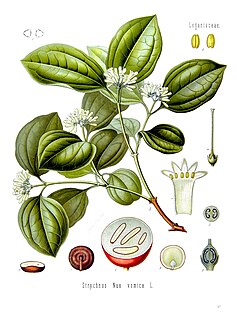
Strychnos nux-vomica, the strychnine tree, also known as nux vomica, poison fruit, semen strychnos, and quaker buttons, is a deciduous tree native to India and to southeast Asia. It is a medium-sized tree in the family Loganiaceae that grows in open habitats. Its leaves are ovate and 5–9 centimetres (2–3.5 in) in size. It is known for being the natural source of the extremely poisonous compound strychnine.

The maned rat or (African) crested rat is a nocturnal, long-haired and bushy-tailed East African rodent that superficially resembles a porcupine. The world's only poisonous rodent, the maned rat borrows toxins from plants to fend off predators.
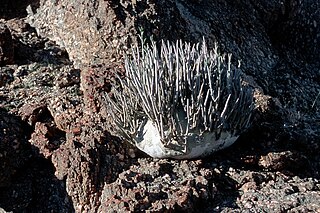
Adenia is a genus of flowering plants in the passionflower family, Passifloraceae. It is distributed in the Old World tropics and subtropics. The centers of diversity are in Madagascar, eastern and western tropical Africa, and Southeast Asia. The genus name Adenia comes from "aden", reported as the Arabic name for the plant by Peter Forsskål, the author of the genus.

Acokanthera is a genus of flowering plants in the family Apocynaceae. It comprises 5 species and is generally restricted to Africa, although Acokanthera schimperi also occurs in Yemen. Its sap contains the deadly cardiotoxic glycoside ouabain. The sap is among the most commonly used in arrow poisons, including those used for poaching elephant.
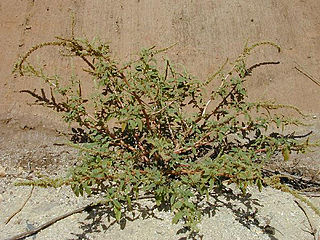
Amaranthus spinosus, commonly known as the spiny amaranth, spiny pigweed, prickly amaranth or thorny amaranth, is a plant that is native to the tropical Americas, but is present on most continents as an introduced species and sometimes a noxious weed. It can be a serious weed of rice cultivation in Asia.

Amaranthus tricolor, known as edible amaranth, is a species of flowering plant in the genus Amaranthus, part of the family Amaranthaceae.
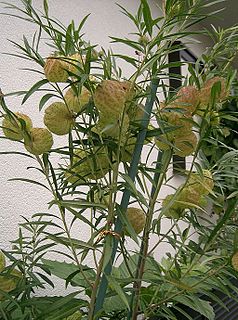
Gomphocarpus physocarpus, commonly known as hairy balls, balloonplant, balloon cotton-bush, bishop's balls, nailhead, or swan plant, is a species of dogbane. The plant is native to southeast Africa, but it has been widely naturalized. It is often used as an ornamental plant.

Plant Resources of Tropical Africa, known by its acronym PROTA, is a retired NGO and interdisciplinary documentation programme active between 2000 and 2013. PROTA produced a large database and various publications about Africa's useful plants.
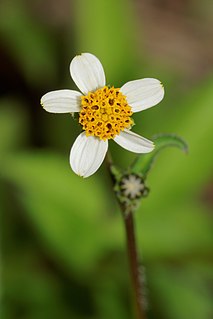
Bidens pilosa is an annual species of herbaceous flowering plant in the daisy family Asteraceae. Its many common names include hitch hikers, black-jack, beggarticks, farmer’s friends and Spanish needle, but most commonly referred to as cobblers pegs. It is native to the Americas but is widely distributed as an introduced species in other regions worldwide including Eurasia, Africa, Australia, South America and the Pacific Islands.

Acalypha indica is an herbaceous annual that has catkin-like inflorescences with cup-shaped involucres surrounding the minute flowers. It is mainly known for its root being attractive to domestic cats, and for its various medicinal uses. It occurs throughout the Tropics.

Acalypha fruticosa is a species of flowering plant in the botanical family Euphorbiaceae. It occurs widely in East and southern Africa where it is eaten as a vegetable. It is also an important browse plant for sheep. In East Africa and southern Africa it is used as a medicinal plant. In northern Kenya arrow shafts and beehive lids are made from the stem. From the dried leaves a tea is made in Ethiopia.
Acalypha integrifolia is a species of flowering plant in the botanical family Euphorbiaceae. It is locally used as a medicinal plant. Leaf decoctions are drunk to treat intestinal worms.
Acalypha ornata is a species in the botanical family Euphorbiaceae. In Africa it is widely used as a medicinal plant. The stems are used as fibres for weaving baskets. The leaves are eaten as a vegetable; the plants are also fed to domestic animals. Acalypha ornata is sometimes planted as an ornamental plant.
Acalypha psilostachya is a species in the botanical family Euphorbiaceae. In East Africa it is used as a medicinal plant.

Aloe buettneri is a species of succulent plant in the family Asphodelaceae. It is found in West Africa and is known for its medicinal uses.

Hymenocardia acida is a plant of the family Phyllanthaceae native to tropical Africa. It is a small tree that grows to 10 m tall. Occurs in the Guinea and Sudanian savannah zones and deciduous woodland, from Senegal eastwards to Ethiopia and southwards reaching Zimbabwe.

Adenia globosa is a species of flowering plant in the passionflower family, Passifloraceae. It is native to tropical Africa, where it occurs in Ethiopia, Kenya, Somalia, and Tanzania. It is known as mpaga in Swahili.

Acokanthera oblongifolia is a plant in the family Apocynaceae. It grows as an evergreen shrub or small tree up to 6 metres (20 ft) tall. Its fragrant flowers feature a white tinged pink corolla. The berries are purple when ripe. Its habitat is dry forest and coastal thickets. Acokanthera oblongifolia is used in local African medicinal treatments for snakebites, itches and internal worms. The plant has been used as arrow poison. The species is native to Mozambique and South Africa.

















